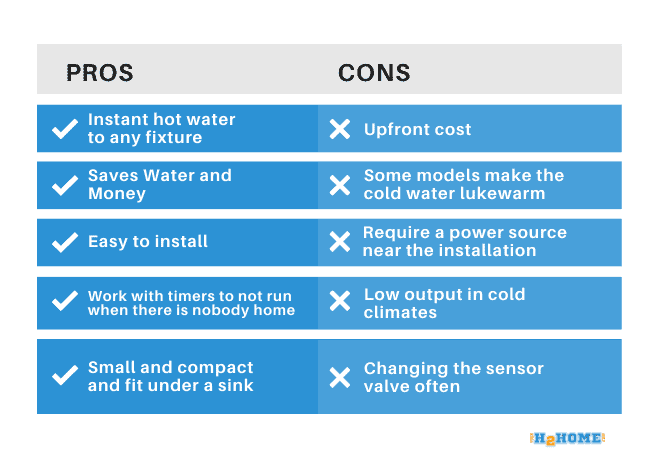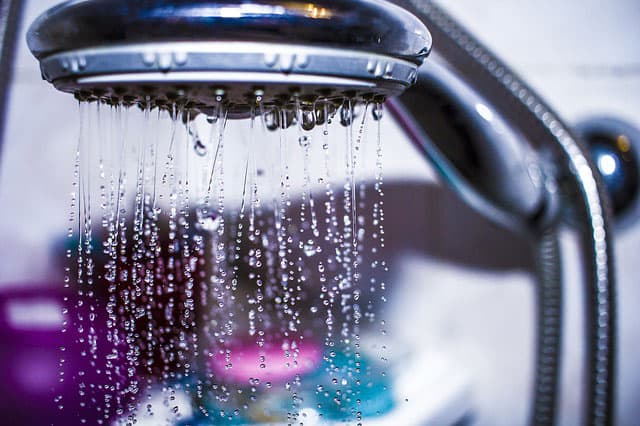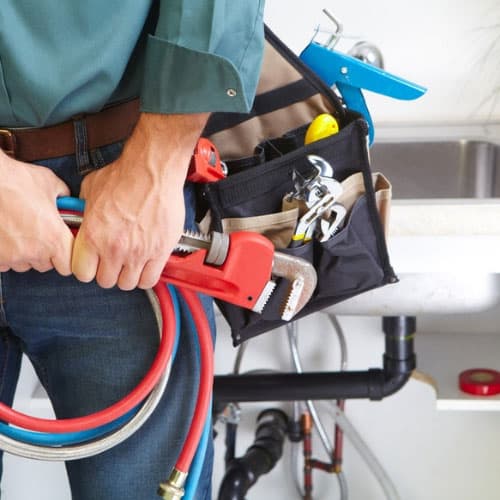Are you curious about the pros and cons of a hot water recirculation pump?
Yes you get instant hot water when you turn on the faucet, but is it worth the upfront installation cost? Do they work in cold climates?
You’ve got questions and I’ve got the answers.
In this article I will highlight everything you need to know about recirculation pumps. There are several options to getting instant hot water so you need to understand which one will fit your needs best and if it is even worth it to buy one.
10 Pros and Cons of Recirculating Pumps
When winter approaches people usually ask about recirculating pumps. While there are many pros and cons, but here are a few of the most important.
Pro #1 Instant Hot Water
The main reason people buy recirculating pumps is to get instant hot water to any fixture. Especially in colder climates, this is a huge benefit.
While there are many ways to get almost instant hot water, recirculating pumps are the most efficient.
Pro #2 Saves Money (Wastes Less Water)
Based on the average water consumption of a family of 4, you can expect to save $50-$75 a year on water costs. If you have an even larger family, you will be able to pay off the investment of a recirculating pump within 2 years.
Con #1 Upfront Cost
While recirculating pumps will save you money over time, they do cost on average about $200 up front. And if you hire a plumber, the total cost of installation can be between $500 and $1000.
Con #2 Requires Nearby Power Source
This may not be a problem if you have a nearby power source under your sink. But if you don’t have a plug nearby, you will need to install one.

What is a Hot Water Recirculation Pump?
A hot water recirculation pump provides instant hot water to any fixture in your home. They are installed above your water heater and work through a motion sensor placed near water fixtures. The sensor valve knowns when your water drops below a certain temperature, and automatically pumps more hot water to your system.
The main benefit of a hot water recirculating pump is not having to wait for hot water. But recirculating pumps also keep your pipes from freezing in the winter.
If you want in depth reviews of the best pumps then check out this detailed buyer guide for recirculating pumps.
How Does a Hot Water Recirculation Pump Work?
Think about how things go when you don’t have a pump.
Your tank heats your water to the temperature that you like. But, it doesn’t pump the water to your faucet until you turn it on. So, that water sitting in your pipes from the tank to your faucet ends up cooling to the ambient temperature.
Now, you turn on the hot water and wait for the heated water to finally arrive. In some cases over a minute, which then washes all that water down the drain.
With a recirculation pump, the idea is that there is a flow of continuous hot water through the pipe so there is no wait for hot water. It is already hot at the point of arrival.
How does this work? Different units work differently, but the idea is that the pump keeps the hot water moving through the pipe where it either ends up back to the boiler with a dedicated line or there is a system in which the hot water runs through the cold water pipes.
I’ll go over the way different ones work in a bit.
Is a Hot Water Recirculating Pump Worth It?
A hot water recirculating pump will save you money, especially if you have a larger family. A family of 4 with normal water usage can expect to save $50-$75 a year. Since pumps cost about $200 each, the recirculating pump will pay for itself in 3-4 years. .
The calculations are based on how much water do we waste by waiting for hot water. If it takes a minute for your water to arrive at the tap or shower, you just dumped at least 1.5 gallons down the drain with the shower and 2 gallons at the kitchen sink.
Add that up over a year and you can see how much water is wasted.
- Rated power: 93/67/46 W. NPT 3/4 inch (19.05 mm) inlet/outlet....
- Easy installation, only need a wrench to connect the pump to the pipeline,...
- Prevent pipes from freezing in winter, especially for cold winter areas. In...
- The circulation water pump features high efficiency with low consumption....
- KOLERFLO circulation water pump RS15-6 Used in Suitable for city buildings,...
What About the Electricity to Run the Pump?
This is where what kind of pump you get really matters. If you have the traditional one that is basically pumping water all the time, then you are actually costing yourself money in the long run. They don’t typically use a lot of electricity as they are very small pumps, but they certainly are not saving money.
The basic answer is no they won’t save you money.
I still think they are worth it, but first, let’s talk about the different kinds because this will make a big difference.

Types of Recirculating Pumps
There are essentially two different kinds of recirculation pumps that you will likely to be looking into.
Traditional Full Recirculating and Under Sink Recirculating Pump Comfort System.
Both have their pros and cons, but understanding each of them will help you decide which one is going to be right for you.
Traditional Full Recirculating
For many years this is what you likely would have gotten if you were looking to get instant hot water to your fixtures. In fact, many hotels around the world use this system for the convenience and comfort of their guests.
This pump be placed over the boiler will circulate the hot water from the tank to your faucet. At the furthest point from the boiler, you’ll need a dedicated hot water line that runs back to the tank, creating a perfect hot water loop.
Now, that doesn’t mean that you’ll have hot water circulating 24 hours a day through that line. Almost all recirculating pumps these days will have a timer on it so it only starts the recirculating at the hours when you’re likely to need the instant hot water.
What makes this a not so attractive option for people is that it requires some additional plumbing to bring that loop together. You’ll need a plumber to run a considerable length of pipe and hook everything up. This can add a lot to the installation costs.
- The recirculating pump uses a heavy-duty stainless steel pump head with...
- System includes pump, 24hr programable timer, sensor valve with thermal...
- Extremely quiet and energy efficient this system supplies instant hot water...
- A sensor valve opens when the water on the hot water side cools, pushes the...
- Pump mounts directly onto water heater, can be used with all types of pipe,...
Under Sink Recirculating Pump Comfort System
This is the most likely option that many of you will be looking at. In fact, from this point on I will only be referring to this type of pump as the other is not a great option for most people.
The way this one works is that the pump is installed under your skin, or at least close to the point of use. Instead of needing a dedicated line that loops back to the boiler, this one has a sort of connector that runs between the hot and cold water lines at the outlet. It has a toggle that will open up when the pump is running that allows the hot water to pass through to the cold water line when the faucet is not open. Then the water cycles back to the boiler through the cold water line.
These types all work on timers, too so it is only on when you are home so it isn’t pumping water through the lines when nobody needs it.
The downside to this version is that since hot water is entering the cold water line, then when you want cold water, you have to let the water run a bit to flush out the warm water.
Check It Out
Watch out for units that have the sensor valve inside the pump. If it fails you need to buy a whole new pump. Other models like this one from Watts have it outside so it can be quickly and easily replaced.
Tankless Water Heaters with Recirculating Pump
A sort of third option is to have a tankless water heater that comes preinstalled with a recirculating pump or is at least ready for one to be added.
Do you have a tankless water heater yet? Then read this article about tankless water heaters and recirculating pumps.
This is a great option to have as you are not only heating water only when you need it, but it provides endless hot water that arrives at your preferred temperature instantly.
For many people having a tank boiler system is grossly inefficient and would rather have a tankless that provides endless hot water. One of the downsides is the wait for the water to heat which is solved by the recirculation pump.
They are not a great idea for everybody so make sure you click the link I provided to the article and read it carefully before deciding to go for a tankless.

Installation Costs for Recirculation Pumps
How much does it cost to install a recirculation pump?
It will cost from $500 to $1000 to install a recirculating pump if you hire a plumber. But of course, it can end up costing as low as zero dollars if you get an under sink recirculating pump and install it yourself.
This is a big reason why I suggest this type of pump over the traditional over boiler ones that require a plumber to run a dedicated line. Unless you can do that yourself it can cost quite a bit to hire a plumber. And even if you do it yourself, you are going to have to pay for a long length of piping and material.
An under sink one can be installed in a matter of minutes. The only thing you may need to pay for is a power source if you don’t have any outlet near your point of use.
The unit you get will likely contain all the hoses and connectors so you won’t be out of pocket by needing to buy all that stuff separately.
Should You Buy a Recirculating Pump System?
Although there are both pros and cons to recirculating pumps, I believe the comfort of instant hot water is worth it.
And furthermore, if you are like me, you hate the thought of wasting water.
No, they won’t really save you any money in the short or long term. And, they do need to be put on a timer to keep them from running all day and night, although you can turn off your recirculating pump if you want to.
The cost of a recirculation pump is not that much and installation is easy enough to do it yourself, so it is an easily afforded luxury that at the same time will make your house less wasteful of our precious natural resource.

Nick Lopresti is the founder of YourH2Home and a home improvement expert. He has years of experience writing about various home improvement topics, mostly as it pertains to water systems.

